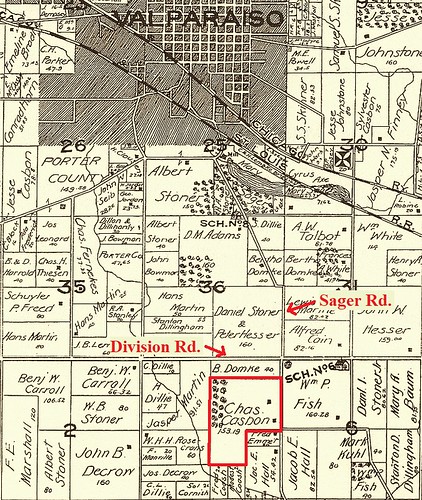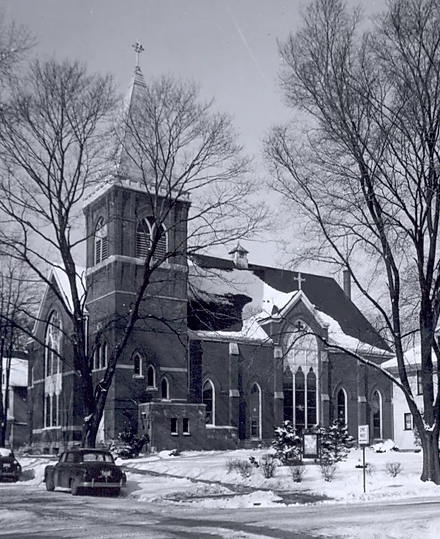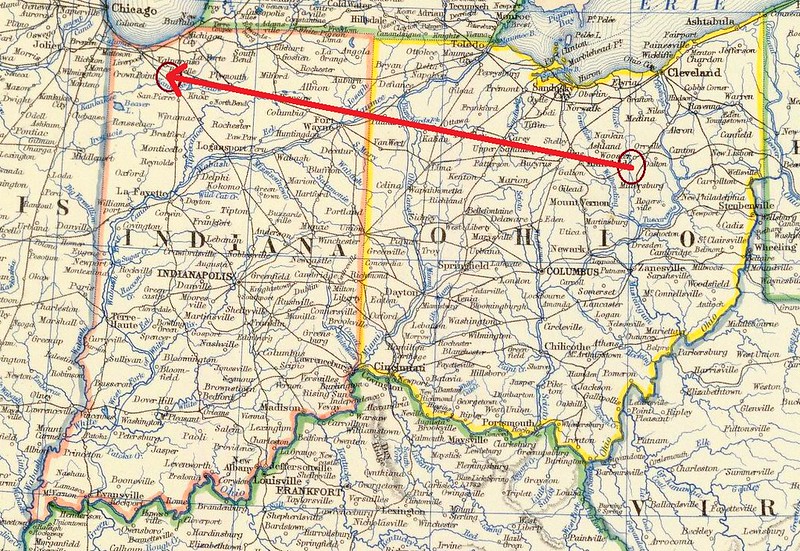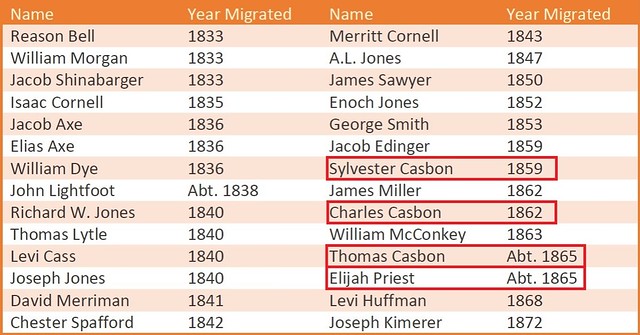Death certificates can be a valuable source of information, especially when other sources about a given person are limited or cannot be found. However, the accuracy of the information is often questionable, depending on how and by whom the information was obtained. Both of these statements apply to the death certificate of Mary (Payne) Casbon, third wife and widow of James Casbon (~1813–1884).[1]
 (Click on image to enlarge)
(Click on image to enlarge)
I just found this death certificate on Ancestry last week. It did not come up on earlier searches because her last name was transcribed as Carbon instead of Casbon. Before finding this, the only sources I had concerning Mary were her 1876 marriage registration, 1880 and 1900 U.S. censuses, and an entry on FindAGrave.com. Let’s take a closer look at her death certificate to see what it can tell us.

(Click on image to enlarge)
The top section of the certificate gives Mary’s name as “Mary P. Casbon.” The “P” probably stands for Payne, her maiden name. Although the “s” in her surname does look somewhat like an “r,” it is distinctly different than the “r” in her first name. The certificate gives the place of death as Center Township in Porter County. No town, city or street address is given. If she had died in Valparaiso, the county seat and main population center of the township, I would have expected that to be written. This could simply be a clerical oversight, but it could also mean that she died elsewhere in the township, outside of city limits. I’ll return to this thought in a few paragraphs.

(Click on image to enlarge)
You’ll notice that the “Personal and Statistical Particulars” section of the certificate was completed by Charles Casbon, the informant for the death certificate. This would have been Charles Thomas Casbon (1840–1915), son of Thomas (~1803–1888) and nephew of Mary’s deceased husband, James. It’s interesting to me that Charles was the informant. Mary had two step-children living in Porter County—Amos and Alice—both children of James by his previous wife, Mary (Jackson, ~1833–before 1876). (James’ other daughter Margaret had just died on April 30, 1903, in La Porte County.[2]) Why wasn’t either Amos or Alice the informant? I’ve been told that Mary and her step-children weren’t on the best of terms, but this may not be the reason. They lived several miles further south, in Porter Township. Not only was Charles closer, but it’s even possible that Mary was staying with him at the time of her death.
In the 1900 census, Mary was living in Hebron, in the southern part of the county.[3]

Detail from 1900 U.S. Census, Hebron Town, Boone Township, Porter County, Indiana. (image is a composite, placing column headings next to Mary’s entry; click to enlarge)
Of note is that fact that Mary lived with a “servant,” named Mary E. Lytle, who’s occupation is listed as “Nurse.” This suggests that Mary’s illness had been longstanding. Incidentally, Mary Lytle was almost certainly the widow of Thomas G. Lytle, a wealthy manufacturer and former three-time mayor of Valparaiso.[4] I suspect that, rather than a servant, she was more of a live-in nurse and caregiver.
If Mary’s home was Hebron, why was she in Center Township when she died? Perhaps in her final illness, she could either no longer afford or was too sick to live on her own. It might have been easier to get the medical care she needed in Valparaiso. If so, staying with a relative would have been a practical solution. A 1902 Valparaiso City Directory lists Charles’ address as “Cemetery av[e] (outside City Limits).[5]” Cemetery Avenue is known today as Linwood Avenue, and leads from the city to the western edges of Graceland and Maplewood cemeteries. If Mary had been staying with Charles, this would explain why her place of death was listed as Center Township and not Valparaiso proper.
The fact that Charles was the informant doesn’t mean he could be counted on to provide accurate information for the death certificate. As a step-nephew, it’s unlikely that he had the detailed knowledge to correctly answer questions about Mary’s life.
For example. Charles gives Mary’s birth date as May 4, 1833. We don’t know Mary’s real date of birth, but on the 1900 census, it was given (presumably by her) as October, 1832.[6] Her grave stone shows her age at death as “69 yrs 8 mos & 20 d,” which would give her a birthdate of about August 20, 1833.[7] So, the best we can say about her birthdate is “about 1832 or 1833.”
Charles said that Mary’s father’s name was Samuel Payne and mother’s as “do not know.” It’s possible that Charles was correct, but we can’t rely on this as first-hand information. It’s easy to get names confused unless one knows the individuals in question. Unfortunately, we have to take everything in this section of the certificate with a grain of salt.
The next section of the certificate tells us why Mary died.

(Click on image to enlarge)
This section was completed by a doctor, which means the handwriting can be a challenge. Fortunately, I have a lot of experience reading doctors’ handwriting.
We see the date of death written as May 10, 1903. This is interesting for a couple of reasons. First of all, her grave stone gives the date as May 9. Why the difference? If we read on, the attending physician writes that he last saw Mary alive on May 6th, and that the time of death is documented as twelve o’clock a.m. Did she really die at exactly midnight? I doubt it. What seems more likely to me is that she died sometime on the 9th, then the doctor was called, and he arrived to pronounce her dead sometime around midnight. At any rate, even though the date on the grave stone may be when she actually died, the date on the death certificate is the official date.
Now look closely at the Chief and Immediate causes of death. They are both surprising and sobering. The chief cause of death is listed as Morphinism, and the immediate cause, Starvation. In other words, Mary was addicted to morphine and her addiction had progressed to the point that she was no longer eating, so that she starved to death.
I have a copy of The Principles and Practice of Medicine, written by William Osler, M.D., and published in 1901. Here’s what it has to say about morphinism.
Morphia Habit (Morphinomania; Morphinism). This habit arises from the constant use of morphia—taken at first, as a rule, for the purpose of allaying pain. The craving is gradually engendered, and the habit in this way acquired. … The habit is particularly prevalent among women and physicians who use the hypodermic syringe for the alleviation of pain. … The confirmed opium-eater often presents a very characteristic appearance. There is a sallowness of the complexion which is almost pathognomonic, and he becomes emaciated, gray, and prematurely aged. He is restless, irritable, and unable to remain quiet for any time. … Persons addicted to morphia are inveterate liars, and no reliance whatever can be placed upon their statements. In many instances this is not confined to matters relating to the vice. … Finally a condition of asthenia is induced, in which the victim takes little or no food and dies from the extreme bodily debility.[8]
This last statement appears to be exactly what happened to Mary.
Dr. Osler goes on to say:
The condition is one which has become so common, and is so much on the increase, that physicians should exercise the utmost caution in prescribing morphia … . Under no circumstances should a patient be allowed to use the hypodermic syringe, and it is even safer not to intrust this dangerous instrument to the hands of the nurse.[9]
There is a striking parallel between Mary’s addiction and today’s “opioid crisis.” A recent article in Smithsonian says
By 1895, morphine and opium powders, like OxyContin and other prescription opioids today, had led to an addiction epidemic that affected roughly 1 in 200 Americans. Before 1900, the typical opiate addict in America was an upper-class or middle-class white woman. Today, doctors are re-learning lessons their predecessors learned more than a lifetime ago.[10]
We don’t know how or why Mary became addicted, but there is a decent chance that it was legally prescribed for her at some point. One hundred fifteen years later, our country is still seeking solutions to the problem of opioid addiction.
The attending physician who signed Mary’s death certificate was Otis B. Nesbit, M.D. The 1912 History of Porter County Indiana describes him in these terms: “Possessing an excellent knowledge of the science which he has chosen as a profession, Otis B. Nesbit, M.D., of Valparaiso, has acquired prominence as a physician and built up a most satisfactory patronage in the city and its suburbs.”[11] He received his medical degree in 1902 having previously received a degree as a pharmacist.[12] When Mary died, in 1903, he would have just been building up his practice, and may very well have been the newest physician in town. As such, he might have taken on cases that his colleagues preferred not to deal with, and Mary’s could easily have been such a case.
The final section of the death certificate contains two names of minor historical interest. The place of burial is given as Maple Wood (now Maplewood) cemetery, and the undertaker’s name is F.A. Lepell. A 1902 Valparaiso city directory lists Frank A. LePell as an “undertaker, embalmer and funeral director, also picture frames and mouldings.”[13] Mr. LePell came from a long line of undertakers, originally from Berlin, Germany.[14] His grandfather and father came to Valparaiso in 1842 and “they were the first undertakers and furniture dealers of Porter County.[15]
Under Mr. LePell’s name is the signature of the “Health Officer or Deputy.” Although difficult to make out (doctor’s handwriting again!) this says “A.P. Letherman.” Andrew P. Letherman, M.D. is described as “distinguished not only for his professional knowledge and skill, but as being the longest-established physician in Porter County [in 1912].”[16] Doctor Letherman’s father, also a physician, brought his family to Valparaiso in 1853.[17] His son, A.P., graduated from medical school in 1871, and thence began his own practice in Valparaiso.[18]
As stated in the death certificate, Mary Payne Casbon was buried in Maplewood Cemetery. She has a nice memorial with this inscription: “Sleep on dear Sister and take thy rest/ To call the[e] home God thought it best.”[19] The word Sister has me puzzled. Did Mary have an actual sister living in Valparaiso, or does this simply mean Sister as a term of endearment for a fellow Christian?

(Click on image to enlarge)
[1] Indiana, State Board of Health, Certificate of Death, Porter County, p. 39 (stamped), Mary P Carbon, 10 May 1903; imaged as “Indiana, Death Certificates, 1899-2011,” Ancestry (https://www.ancestry.com/interactive/60716/45232_354312-00338 : accessed 27 April 2018), Certificate >1903 >10, image 339 of 2788; citing Indiana State Board of Health. Death Certificates, 1900–2011, Microfilm, Indiana Archives and Records Administration, Indianapolis.
[2] Indiana, State Board of Health, Certificate of Death, La Porte County, p. 54 (stamped), Maggie Biederstadt, 30 Apr 1903; imaged as “Indiana, Death Certificates, 1899-2011,” Ancestry (https://www.ancestry.com/interactive/60716/45232_354308-02082 : accessed 1 May 2018), Certificate >1903 >6, image 2083 of 2771; citing Indiana State Board of Health.
[3] 1900 U.S. Census, Porter County, Indiana, population schedule, Boone Township, enumeration district 79, sheet 13A, p. 13 (stamped), dwelling 315, family 316, Casben, Mary; imaged as “United States Census, 1900,” FamilySearch (https://www.familysearch.org/ark:/61903/3:1:S3HY-6QNS-36R?i=25&cc=1325221 : accessed 27 April 2018), Indiana > Porter > ED 79 Boone Township Hebron town, image 26 of 29; citing NARA microfilm publication T623, roll 398.
[4] Weston A. Goodspeed & Charles Blanchard, Counties of Porter and Lake Indiana: Historical and Biographical, Illustrated (Chicago: F.A. Battey & Co., 1882), pp. 257-8; online image, Internet Archive (https://archive.org/stream/countiesofporter00good#page/258/ : accessed 1 May 2018).
[5] Bumstead’s Valparaiso City and Porter County Business Directory (Chicago: Bumstead & Co., 1902), p. 67; imaged as “U.S. City Directories, 1822-1995,” Ancestry (https://www.ancestry.com/interactive/2469/11567377#?imageId=11567418 : accessed 1 May 2018), Indiana >Valparaiso >1902 >Valparaiso, Indiana, City Directory, 1902, image 22 of 159.
[6] 1900 U.S. Census, Porter County, Indiana, pop. sched., Boone Township, en. dist. 79, sheet 13A, p. 13, dwell. 315, fam. 316 (stamped), Casben, Mary.
[7] Find A Grave, database with images (https://www.findagrave.com/memorial/109800943/mary-casbon : accessed 27 April 2018), memorial page for Mary Payne Casbon (1833-1903), ID no. 109800943, created by Alana Knochel Bauman; citing Maplewood Cemetery, Valparaiso, Indiana.
[8] William Osler, M.D., The Principles and Practice of Medicine: Designed for the Use of Practitioners and Students of Medicine, 3d ed. (New York: D. Appleton & Co., 1901), p. 384.
[9] Ibid.
[10] Erick Trickey, “Inside the Story of America’s 19th-Century Opiate Addiction,” 4 Jan 18, Smithsonian.com (https://www.smithsonianmag.com/history/inside-story-americas-19th-century-opiate-addiction-180967673/ : accessed 1 May 2018).
[11] History of Porter County Indiana: a Narrative Account of its Historical Progress, its People and its Principal Interests, vol. 2 (Chicago: Lewis Publishing Co., 1912), pp. 545-6.; online image, Hathi Trust Digital Library (https://babel.hathitrust.org/cgi/pt?id=wu.89067919191;view=1up;seq=203 : accessed 28 April 2018).
[12] Ibid, p. 545.
[13] Bumstead’s Valparaiso City and Porter County Business Directory, p. 106; Ancestry (https://www.ancestry.com/interactive/2469/11567377#?imageId=11567418 : accessed 1 May 2018 ), image 42 of 159.
[14] Pictorial and Biographical Record of La Porte, Porter, Lake and Starke Counties, Indiana (Chicago: Goodspeed Brothers, 1894), p. 505; online image, Internet Archive (https://archive.org/stream/pictorialbiograp00chic#page/504 : accessed 1 May 2018).
[15] Ibid.
[16] History of Porter County, Indiana, vol. 2, p. 445; Internet Archive (https://babel.hathitrust.org/cgi/pt?id=wu.89067919191;view=1up;seq=101 : accessed 1 May 2018).
[17] Ibid, p. 446.
[18] Ibid.
[19] Find A Grave, memorial page for Mary Payne Casbon.










































